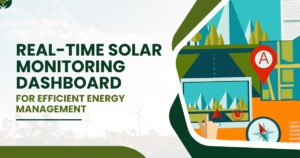As solar energy becomes a primary choice for renewable energy generation, managing and maximizing solar system performance becomes essential. A Real-Time Solar Monitoring Dashboard is a critical tool in this regard, offering users instant insights into energy production, consumption, and efficiency metrics. This article delves into the technical and operational aspects of solar monitoring dashboards, highlighting their importance for effective energy management. We will examine the core features, technical components, and benefits of implementing a real-time solar monitoring dashboard, alongside real-world examples and statistics to underline its significance.
Understanding the Solar Monitoring Dashboard
A Solar Monitoring Dashboard is a digital interface designed to visualize data from solar energy systems. This tool provides real-time data on various metrics, including energy production, weather conditions, and system health, which helps operators optimize energy output and reduce operational costs.
For instance, if a solar panel array underperforms due to shading or technical issues, a solar monitoring dashboard can pinpoint the problem area, allowing for quick resolutions and minimizing energy loss.
Core Features of a Real-Time Solar Monitoring Dashboard
A well-designed Real-Time Solar Monitoring Dashboard offers several essential features for energy management:
-
Real-Time Data Collection:
- Continuous data collection is fundamental. Advanced dashboards gather data from various components, including solar inverters, batteries, and weather sensors.
- Instant data updates enable users to make timely adjustments to optimize solar energy production.
-
System Health Monitoring:
- Solar systems involve numerous components like inverters, batteries, and panels. Tracking the health of these components in real-time helps prevent system downtime.
- For example, when a component’s performance deviates from standard parameters, an alert is triggered, prompting necessary maintenance.
-
Historical Data Analysis:
- Storing and analyzing historical data allows users to understand long-term performance trends. This feature helps in identifying seasonal patterns, performance anomalies, and opportunities for improvements.
- Monthly and yearly reports provide valuable insights for forecasting future energy production.
-
Energy Production Forecasting:
- Integrating weather forecasts and historical data, these dashboards predict future energy production. Accurate forecasting assists in planning energy storage or backup requirements.
- For instance, with an accurate production forecast, commercial setups can allocate energy to storage or optimize usage, reducing dependency on grid power.
-
Interactive Visualizations:
- Visual elements like graphs, charts, and heat maps help users interpret data effectively. A color-coded system, for instance, highlights areas of high or low energy production.
Technical Components of a Solar Monitoring Dashboard
The technical structure behind a Real-Time Solar Monitoring Dashboard is crucial for reliable performance. Here are some key components:
-
Data Acquisition System:
- Collects data from solar panels, inverters, and environmental sensors.
- Advanced monitoring dashboards often use IoT sensors that connect directly to each panel, ensuring granular data on a per-panel basis.
-
Backend Processing:
- Processes raw data into actionable metrics. Backend algorithms calculate real-time energy production, system efficiency, and potential issues.
- Cloud-based solutions are commonly used for data storage, making data accessible from anywhere.
-
User Interface (UI):
- Designed for ease of navigation, the UI shows data in a simple, user-friendly format. Dashboards use responsive design to function on desktops, tablets, and smartphones.
-
Notification System:
- Sends alerts for maintenance or operational anomalies. An effective system categorizes alerts based on severity, guiding users on the required action.
-
Data Security Protocols:
- Since dashboards often contain sensitive energy data, encryption and secure data storage are necessary to prevent unauthorized access.
Benefits of Using a Real-Time Solar Monitoring Dashboard
-
Increased Energy Efficiency:
- Real-time monitoring enables prompt actions to maintain optimal energy output. Small adjustments in angle, shading, or component alignment can lead to measurable gains in energy production.
-
Reduced Maintenance Costs:
- Proactive monitoring means less need for unplanned maintenance. By identifying issues early, costly repairs are avoided, extending the lifespan of solar equipment.
-
Enhanced Decision-Making:
- With immediate access to critical data, decision-makers can optimize energy distribution, storage, and overall energy strategy. Real-time data allows users to react to production changes quickly.
-
Environmental Benefits:
- Improved energy management reduces dependency on grid power, resulting in lower greenhouse gas emissions. This makes solar monitoring dashboards essential for environmentally conscious operations.
-
Cost Savings:
- A solar monitoring dashboard can significantly reduce operational costs by ensuring that all equipment functions optimally. Many users report a return on investment within months of installation due to lower energy expenses.
Real-World Application Examples
-
Residential Solar Systems:
- Homeowners using solar monitoring dashboards can better manage energy usage, shifting consumption to peak production hours and reducing grid dependence.
- Example: A study by the National Renewable Energy Laboratory (NREL) showed that households using solar monitoring dashboards reduced electricity bills by an average of 20%.
-
Commercial and Industrial Solar Plants:
- Larger facilities benefit significantly, as dashboards streamline monitoring across hundreds of panels. Real-time data helps in maintaining consistent production levels.
- Example: A 5 MW solar farm in California reported a 15% increase in operational efficiency within six months of implementing a real-time monitoring dashboard.
-
Utility-Scale Solar Farms:
- For massive installations, dashboards provide control over distributed solar assets. Operators can track each segment’s performance, schedule maintenance, and anticipate production dips due to weather.
Statistical Evidence Supporting Solar Monitoring Dashboards
- According to the International Renewable Energy Agency (IRENA), real-time monitoring can improve solar efficiency by 15-20%.
- A study from Berkeley Lab indicates that monitoring systems reduce annual maintenance costs by 10-15%, as early issue detection prevents costly repairs.
- NREL data shows that utility-scale solar farms using monitoring dashboards have achieved up to a 30% improvement in overall energy efficiency.

 Read More: Understanding the cost of installing a solar panel system
Read More: Understanding the cost of installing a solar panel system
Challenges in Implementing Solar Monitoring Dashboards
-
Data Overload:
- For some users, the amount of data can be overwhelming. A well-designed dashboard should filter data to show only critical metrics.
-
Integration with Legacy Systems:
- Older solar systems may lack compatibility with modern monitoring technology. Retrofitting older systems for real-time monitoring can incur additional costs.
-
Cost of Implementation:
- Initial setup and maintenance of a solar monitoring dashboard can be costly, especially for smaller installations. However, the long-term benefits often outweigh these initial expenses.
Future Trends in Solar Monitoring Dashboard Technology
-
Artificial Intelligence (AI) and Machine Learning:
- AI and machine learning can analyze historical data to predict equipment malfunctions or optimize energy distribution based on consumption patterns.
-
Enhanced Security Measures:
- With data security becoming a priority, future dashboards will likely incorporate advanced encryption and real-time cyber threat monitoring.
-
Integration with Energy Storage Systems:
- Real-time solar monitoring dashboards will increasingly connect with energy storage systems. This will enable users to control storage levels based on real-time production and consumption, making systems more efficient and self-reliant.
-
IoT and Smart Grid Compatibility:
- Dashboards will work more seamlessly with smart grid systems, allowing for dynamic energy pricing and optimized energy flows based on grid demands.
Conclusion
A Real-Time Solar Monitoring Dashboard is indispensable for effective solar energy management. By offering immediate insights into energy production, system health, and environmental data, these dashboards empower users to make data-driven decisions that maximize energy efficiency, minimize costs, and reduce environmental impact. As solar technology evolves, these dashboards will continue to integrate with AI, IoT, and smart grid technologies, further enhancing their role in sustainable energy management.
Efficient energy management requires timely access to actionable data, and a real-time solar monitoring dashboard provides precisely that. Investing in such a solution ensures a greener, more cost-effective, and sustainable future for individuals, businesses, and industries.
















































